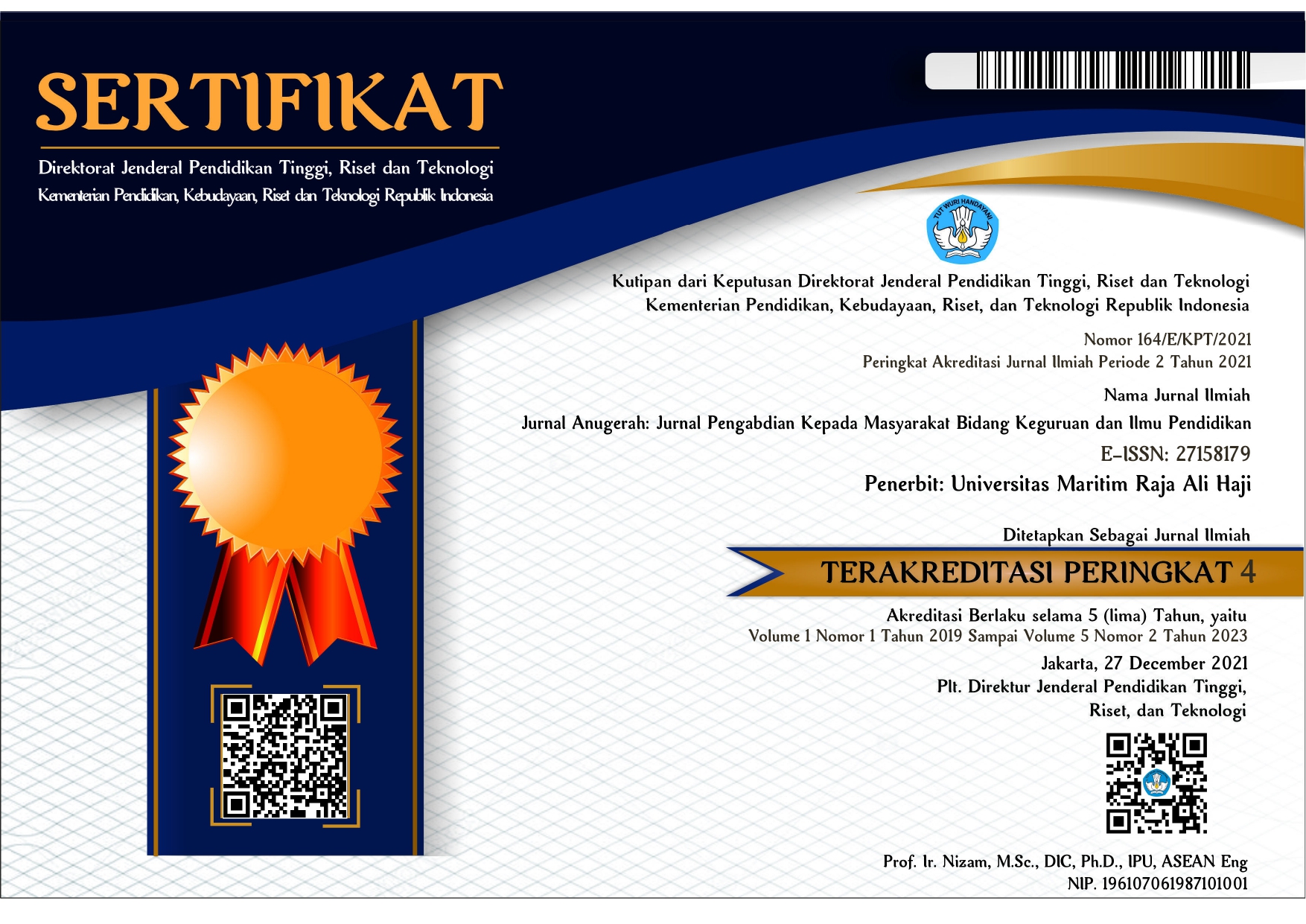Mengenal Nominal Sentences dengan Stepping the 5 Stairs “B†Teknik bagi Anak-anak Pesisir yang Belajar Grammar
DOI:
https://doi.org/10.31629/anugerah.v2i2.2645Keywords:
stepping the 5 Stairs, grammar, anak-anak pesisirAbstract
Untuk mengonstruksi kalimat nominal bahasa Inggris perlu menggunakan teknik yang tepat. Teknik itu sendiri menawarkan iklim belajar yang menyenangkan dan mampu membuat penggunanya memahami konsep kontruksi kalimat tersebut dengan baik. Anak-anak pesisir perlu diperkenalkan dengan berbagai macam jenis teknik pembelajaran grammar, salah satunya Stepping the 5 Stairs “Bâ€ÂÂ. Grammar menjadi bagian penting dalam pembelajaran bahasa Inggris. Stepping the 5 Stairs “B†merupakan teknik pembelajaran grammar yang ditawarkan oleh Tim PkM dan sudah didesain sesuai dengan karakteristik anak-anak pesisir tersebut. Tim PkM menggunakan pendekatan deskriptif sebagai metode pelaksanaan kegiatan PkM ini. Semua anggota Tim PkM turun ke lapangan untuk melakukan survei dan menginterview beberapa orang tua dan anak-anak pesisir. PkM ini telah dilaksanakan di Kelurahan Senggarang yang mana tempat ini terkenal dengan wisata religi bagi turis-turis asing. Kegiatan PkM ini menghasilkan: (1) Tingkat pemahaman anak-anak pesisir untuk mengonstruksi kalimar nominal bahasa Inggris meningkat dengan menerapkan teknik Stepping the 5 Stairs “Bâ€ÂÂ, (2) Motivasi belajar mereka sangat positif untuk belajar grammar dengan menggunakan Stepping the 5 Stairs “Bâ€ÂÂ, dan (3) Harapan perangkat desa, orang tua, dan juga anak-anak pesisir adalah bahwa kegiatan PkM ini tetap berlanjut karena Senggarang merupakan tempat tujuan wisatawan asing.
Downloads
References
Abbas, P. G. (2018). The use of technology in English language learning: A literature review. International Journal of Research in English Education, 115–125.
Agust, S. (2017). Mastering the advanced grammar by stepping the 5 stairs up. Tanjungpinang: UMRAH Press.
Agust, S. (2019). Let’s step the stairs to learn grammar. Tanjungpinang: UMRAH Press.
Agust, S., Subroto, G., & Candra, M. (2019). Pentingnya stepping the 5 stairs “A†teknik untuk anak-anak pesisir yang belajar grammar. Jurnal Anugerah, 1(1), 41–49. https://doi.org/10.31629/anugerah.v1i1.1610
Al-mekhlafi, A. M., & Nagaratnam, R. P. (2011). Difficulties in teaching and learning grammar in an EFL context. International Journal of Instruction, 4(2), 69–92.
Conrad, S. (2000). Grammar Teaching in the 21st Century ? *. Tesol Quarterly, 1999(April), 548–560.
Ellis, N. C. (2005). At the interface: Dynamic interactions of explicit and implicit language knowledge. Studies in Second Language Acquisition, 27(2), 305–352. Retrieved from http://www.jstor.org/stable/44486825
Ellis, R. (1995). Interpretation tasks for grammar teaching. TESOL Quarterly, 29(1), 87. https://doi.org/10.2307/3587806
Ellis, R. (2001). Investigating form-focused instruction. In R. Ellis (Ed.), Form-focused instruction and second language learning. Malden: Blackwell Publishing.
Ellis, R. (2002). Does form-focused instruction affect the acquisition of implicit knowledge? A Review of the Research. Studies in Second Language Acquisition, 24(2), 223–236. Retrieved from http://www.jstor.org/stable/44486614
Genclter, B. (2015). How does technology affect language learning process at an early age? Procedia - Social and Behavioral Sciences, 311–316.
Hahn, A. (2000). Grammar at its best: The development of a rule- and corpus-based grammar of English tenses. In L. Bernard & T. McEnery (Eds.), Rethinking language pedagogy from a corpusbased perspective. Bern: Peter Lang.
Harley, B., & Swain, M. (1984). The interlanguage of immersion and its implications for second language teaching. In A. Davies, C. Criper, & A. P. R. Howatt (Eds.), Interlanguage (pp. 291–311). Edinburgh: Edinburgh University Press.
Hasanah, H. U. (2016). Respon mahasiswa terhadap pembelajaran grammar berbasis website. NUANSA: Jurnal Penelitian Ilmu Sosial Dan Keagamaan Islam, 13(1).
Hinkel, E., & Fotos, S. (2002). New perspectives on grammar teaching in second language classrooms. Mahwah, NJ: Erlbaum.
Hosni, S. A. (2014). Speaking difficulties encountered by young EFL learners. International Journal on Studies in English Language and Literature, 22–30.
Hughes, R., & McCarthy, M. (1998). From sentence to discourse: Discourse grammar and English language teaching. TESOL Quarterly, 32(2), 263. https://doi.org/10.2307/3587584
Lightbown, P. M. (2008). Transfer appropriate processing as a model for classroom second language acquisition. In Z. Han (Ed.), Understanding second language process (pp. 27–44). Clevedon, UK: Multilingual Matters. Retrieved from https://www.researchgate.net/profile/Patsy_Lightbown/publication/292461381_Transfer_appropriate_processing_as_a_model_for_classroom_second_language_acquisition/links/5785032008aec5c2e4e10f04/Transfer-appropriate-processing-as-a-model-for-classroom-second-
Lightbown, P. M., & Spada, N. (1990). Focus-on-form and corrective feedback in communicative language teaching: Effects on second language learning. Studies in Second Language Acquisition, 12(4), 429–448.
Liu, D. (2003). Grammar teaching in teacher education. (D. Liu & P. Master, Eds.). International TESOL Association.
Majeed, M. N. A., & Sama, F. R. F. (2018). Teaching grammar in the English language classroom: Perceptions and practices of students and teachers in the Ampara district. In Proceedings of 7th International Symposium (pp. 653–667).
Philp, J. (2003). Constraints on “NOTICING THE GAPâ€ÂÂ: Nonnative speakers’ noticing of recasts in NS-NNS interaction. Studies in Second Language Acquisition, 25(1), 99–126. Retrieved from http://www.journals.cambridge.org/abstract_S0272263103000044
Rabab’ah, G. (2005). Communication problems facing Arab learners of English. Journal of Language and Learning, 180–197.
Ragan, T., Boyce, M., Redwine, D., Savenye, W., & C., M. J. (1993). Is multimedia worth it? Association for Educational Communications and Technology Convention.
Risnawaty. (2018). Pelatihan bahasa Inggris melalui media gambar dengan direct method (metode langsung). In Prosiding Seminar Nasional Hasil Pengabdian 2018 (pp. 323–327).
Romadhon, S. A., & Sungkar, M. S. (2020). Peningkatan vocabulary dan grammar dengan menggunakan metode Make a Match bagi siswa panti asuhan Putera Muslimat Brebes. Jurnal Pendidikan Pembelajaran Pemberdayaan Masyarakat, 175–180.
Yuan, F., & Ellis, R. (2003). The effects of pre-task planning and on-line planning on fluency, complexity and accuracy in L2 monologic oral production. Applied Linguistics, 24(1), 1–27. https://doi.org/10.1093/applin/24.1.1















